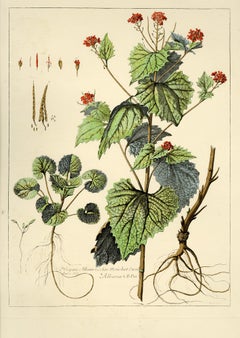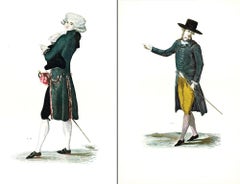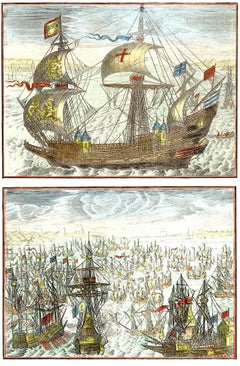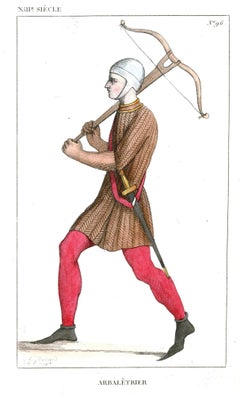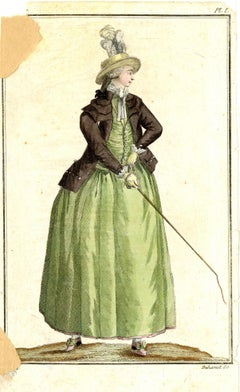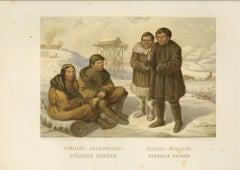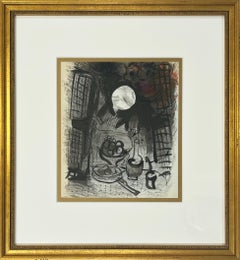Rob Zanger Rare Books LLC Still-life Prints
to
12
9
Overall Width
to
Overall Height
to
10
2
1
16
3
2
12
17
4
12
8
7
7
6
5
5
4
4
3
3
3
3
2
1
1
1
1
1
1
21
21
13
6
6
21
Group of seven (7) prints from Engravings of Plants + 1 Redouté
By Abraham Bosse
Located in Middletown, NY
Each a lithograph with hand coloring on watermarked Arches wove paper with a deckle edge. Each 16 1/4 x 12 1/4 (412 x 312 mm); sheet 26 x 19 3/4 inches (661 x 502 mm), each with full...
Category
Late 17th Century French School Still-life Prints
Materials
Watercolor, Lithograph
Eight 18th century-era fashion plates from the portfolio Modes, by M. Connat
Located in Middletown, NY
Eight 18th century-era fashion plates from the portfolio Modes, by Madeleine Connat.
Paris: Paris Etching Society, 1951. Each an engraving with hand coloring in watercolor on cream ...
Category
20th Century French School Still-life Prints
Materials
Watercolor, Engraving
Two naval images depicting 17th century warships
Located in Middletown, NY
French School 20th century
Two naval images depicting 17th century warships flying various flags, including the Plantagenet Lions and St. George's Cross. (2)
c1950. Two engravings w...
Category
20th Century French School Still-life Prints
Materials
Watercolor, Engraving
A brightly colored image of a 13th century French bowman.
Located in Middletown, NY
Mussard, Léopold
Costume design for a 13th century Arbalétrier.
Paris: 1836. Etching with hand coloring in watercolor on cream wove paper, 5 1/2 x 8 9/16 inches (138 x 216 mm), full...
Category
Early 19th Century French School Still-life Prints
Materials
Watercolor, Handmade Paper, Etching
Group of 19th & 20th century hand colored fashion plates.
Located in Middletown, NY
19th century European
Group of 13 hand-colored English and Continental fashion plates and costume designs.
Each an etching with hand coloring in watercolor. Various sizes and condit...
Category
19th Century English School Still-life Prints
Materials
Watercolor, Handmade Paper, Etching
Sedentary Koryaks; Reindeer/Nomad Koryaks
By John Webber
Located in Middletown, NY
Lithograph with hand coloring in watercolor on cream wove paper with a deckle edge, 8 3/4 x 12 1/2 inches (222 x 320 mm); sheet 15 1/4 x 20 7/8 inches (388 x 530 mm), full margins. I...
Category
Mid-19th Century French School Still-life Prints
Materials
Watercolor, Lithograph
A Sledge of Kamtschatka – An image of a relic from Captain Cook's third voyage
By John Webber
Located in Middletown, NY
London: Scatcherd & Whitaker, 1784.
Etching with hand coloring in watercolor on cream wove paper, 7 1/2 x 10 (190 x 255); sheet 16 1/4 x 22 (414 x 560 mm), full margins. In good cond...
Category
Late 18th Century English School Still-life Prints
Materials
Handmade Paper, Etching, Watercolor
Chrysanthemums and the Rising Moon
By Suzuki (Hozumi) Harunobu
Located in Middletown, NY
An image that originally appeared in an astrological calendar for the year 1766.
Tokyo: Shuei-Sha, 1766. Woodblock print in colors printed on laid mulberry paper, 10 3/4 x 7 7/8 in...
Category
Mid-18th Century Edo Still-life Prints
Materials
Watercolor, Handmade Paper, Woodcut
Aranzo Gigante Verrucoso & Limon di Fior Doppio, 4 prints
Located in Middletown, NY
Joseph de Montalegre (after)
Aranzo Gigante Verrucoso & Limon di Fior Doppio, 4 prints
1702-1725. Four (4) reproductive prints with handcoloring on thick C.M. Fabriano cotton wove ...
Category
Late 17th Century French School Still-life Prints
Materials
Watercolor, Handmade Paper
Bronze Urns with Citrus Trees, 2 prints
Located in Middletown, NY
Pair of reproductive prints after Jean le Pautre’s engravings after Claude Ballin, 1670s, heightened with gouache and gold, on Fabriano wove paper, a deckle edge at bottom. 22 x 14 3...
Category
Late 17th Century French School Still-life Prints
Materials
Handmade Paper, Watercolor
Two botanical prints after Cornelisi Bloemaert & Vincenzo Leonardi
Located in Middletown, NY
Two botanical prints after Cornelis Bloemaert & Vincenzo Leonardi
"Lemon", from Hesperides. Reproductive print on thick C.M. Fabriano cotton wove paper; and Pierre Joseph Buchot (17...
Category
Late 17th Century French School Still-life Prints
Materials
Watercolor, Engraving
4 plates from The Wondrous Transformation of Caterpillars & their Strange Diet..
By Maria Sibylla Merian
Located in Middletown, NY
Four plates from The Wondrous Transformation of Caterpillars and their Strange Diet of Flowers. “Wolfsmelk Rupsen;" “Wolfsmilch, Raupe und Schmetterling" Amsterdam: J F Bernard, 1730. Each an engraving with hand coloring in watercolor and gouache printed on one sheet of watermarked Honig cream laid paper, each measures 6 1/4 x 5 inches (157 x 121 mm), sheet measures 20 5/8 x 14 inches (522 x 355 mm), full margins. With one 1.5 inch inch tear across the area of the top-left corner, well outside of image area. Handling creases in the lower right sheet quadrant, as well as minor, loose cockling, otherwise in very good condition. The colors are superb with exceptionally fresh and bright saturation. Engraved between 1679 and 1683, printed 1730. Plates included: CXXI, CXXII, CXXIII, & CXXIV.
MARIA SIBYLLA MERIAN was one of the most highly respected entomologists of the 17th century, and remains today one of the field's most significant figures. A German-born naturalist and scientific illustrator, she reared herself on the study of caterpillars, and made tremendous contributions to the knowledge of the life cycles of numerous species. Until her detailed and careful study of the process of metamorphosis it was thought that insects were "born of mud," through spontaneous generation.
Trained as a miniature painter by her stepfather, she published her first book of illustrations in 1675, at the age of 28. In 1679, Merian published the first volume of the two-volume series on caterpillars, The Wondrous Transformation of Caterpillars and their Strange Diet of Flowers; the second volume followed in 1683. Each volume contained 50 plates that she engraved and etched. In 1699, Merian traveled to Dutch Guiana...
Category
Early 18th Century Naturalistic Still-life Prints
Materials
Watercolor, Engraving
4 plates from The Wondrous Transformation of Caterpillars & their Strange Diet..
By Maria Sibylla Merian
Located in Middletown, NY
Four plates from The Wondrous Transformation of Caterpillars and their Strange Diet of Flowers. “Wolfsmelk Rupsen;" “Wolfsmilch, Raupe und Schmetterling" Amsterdam: J F Bernard, 1730. Each an engraving with hand coloring in watercolor and gouache printed on one sheet of watermarked Honig cream laid paper, each measures 6 1/4 x 5 inches (157 x 121 mm), sheet measures 20 5/8 x 14 inches (522 x 355 mm), full margins. With handling creases in the lower right sheet quadrant, as well as minor, loose cockling, otherwise in very good condition. The colors are superb with exceptionally fresh and bright saturation. Engraved between 1679 and 1683, printed 1730. Plates included: LIV, LV, LVI, & LVII.
MARIA SIBYLLA MERIAN was one of the most highly respected entomologists of the 17th century, and remains today one of the field's most significant figures. A German-born naturalist and scientific illustrator, she reared herself on the study of caterpillars, and made tremendous contributions to the knowledge of the life cycles of numerous species. Until her detailed and careful study of the process of metamorphosis it was thought that insects were "born of mud," through spontaneous generation.
Trained as a miniature painter by her stepfather, she published her first book of illustrations in 1675, at the age of 28. In 1679, Merian published the first volume of the two-volume series on caterpillars, The Wondrous Transformation of Caterpillars and their Strange Diet of Flowers; the second volume followed in 1683. Each volume contained 50 plates that she engraved and etched. In 1699, Merian traveled to Dutch Guiana...
Category
Early 18th Century Naturalistic Still-life Prints
Materials
Watercolor, Engraving
4 plates from The Wondrous Transformation of Caterpillars & their Strange Diet..
By Maria Sibylla Merian
Located in Middletown, NY
Four plates from The Wondrous Transformation of Caterpillars and their Strange Diet of Flowers. “Wolfsmelk Rupsen;" “Wolfsmilch, Raupe und Schmetterling" Amsterdam: J F Bernard, 1730. Each an engraving with hand coloring in watercolor and gouache printed on one sheet of watermarked Honig cream laid paper, each measures 6 1/4 x 5 inches (157 x 121 mm), sheet measures 20 5/8 x 14 inches (522 x 355 mm), full margins. With handling creases in the lower right sheet quadrant, as well as minor, loose cockling, otherwise in very good condition. The colors are superb with exceptionally fresh and bright saturation. Engraved between 1679 and 1683, printed 1730. Plates included: CI; CII; CIII & CIV.
MARIA SIBYLLA MERIAN was one of the most highly respected entomologists of the 17th century, and remains today one of the field's most significant figures. A German-born naturalist and scientific illustrator, she reared herself on the study of caterpillars, and made tremendous contributions to the knowledge of the life cycles of numerous species. Until her detailed and careful study of the process of metamorphosis it was thought that insects were "born of mud," through spontaneous generation.
Trained as a miniature painter by her stepfather, she published her first book of illustrations in 1675, at the age of 28. In 1679, Merian published the first volume of the two-volume series on caterpillars, The Wondrous Transformation of Caterpillars and their Strange Diet of Flowers; the second volume followed in 1683. Each volume contained 50 plates that she engraved and etched. In 1699, Merian traveled to Dutch Guiana...
Category
Early 18th Century Naturalistic Still-life Prints
Materials
Engraving, Watercolor
3 plates from The Wondrous Transformation of Caterpillars & their Strange Diet..
By Maria Sibylla Merian
Located in Middletown, NY
Three plates from The Wondrous Transformation of Caterpillars and their Strange Diet of Flowers. “Wolfsmelk Rupsen;" “Wolfsmilch, Raupe und Schmetterling" Amsterdam: J F Bernard, 1730. Each an engraving with hand coloring in watercolor and gouache printed on one sheet of watermarked Honig cream laid paper, each measures 6 1/4 x 5 inches (157 x 121 mm), sheet measures 20 5/8 x 14 inches (522 x 355 mm), full margins. With handling creases in the lower right sheet quadrant, as well as minor, loose cockling, otherwise in very good condition. The colors are superb with exceptionally fresh and bright saturation. Engraved between 1679 and 1683, printed 1730. Plates included: XLVIII; XLIX & L.
MARIA SIBYLLA MERIAN was one of the most highly respected entomologists of the 17th century, and remains today one of the field's most significant figures. A German-born naturalist and scientific illustrator, she reared herself on the study of caterpillars, and made tremendous contributions to the knowledge of the life cycles of numerous species. Until her detailed and careful study of the process of metamorphosis it was thought that insects were "born of mud," through spontaneous generation.
Trained as a miniature painter by her stepfather, she published her first book of illustrations in 1675, at the age of 28. In 1679, Merian published the first volume of the two-volume series on caterpillars, The Wondrous Transformation of Caterpillars and their Strange Diet of Flowers; the second volume followed in 1683. Each volume contained 50 plates that she engraved and etched. In 1699, Merian traveled to Dutch Guiana...
Category
Early 18th Century Naturalistic Still-life Prints
Materials
Watercolor, Engraving
4 plates from The Wondrous Transformation of Caterpillars & their Strange Diet..
By Maria Sibylla Merian
Located in Middletown, NY
Four plates from The Wondrous Transformation of Caterpillars and their Strange Diet of Flowers. “Wolfsmelk Rupsen;" “Wolfsmilch, Raupe und Schmetterling" Amsterdam: J F Bernard, 1730. Each an engraving with hand coloring in watercolor and gouache printed on one sheet of watermarked Honig cream laid paper, each measures 6 1/4 x 5 inches (157 x 121 mm), sheet measures 20 5/8 x 14 inches (522 x 355 mm), full margins. With handling creases in the lower right sheet quadrant, as well as minor, loose cockling, otherwise in very good condition. The colors are superb with exceptionally fresh and bright saturation. Engraved between 1679 and 1683, printed 1730. Plates included: No.1:I; No. 2:1; II & III.
MARIA SIBYLLA MERIAN was one of the most highly respected entomologists of the 17th century, and remains today one of the field's most significant figures. A German-born naturalist and scientific illustrator, she reared herself on the study of caterpillars, and made tremendous contributions to the knowledge of the life cycles of numerous species. Until her detailed and careful study of the process of metamorphosis it was thought that insects were "born of mud," through spontaneous generation.
Trained as a miniature painter by her stepfather, she published her first book of illustrations in 1675, at the age of 28. In 1679, Merian published the first volume of the two-volume series on caterpillars, The Wondrous Transformation of Caterpillars and their Strange Diet of Flowers; the second volume followed in 1683. Each volume contained 50 plates that she engraved and etched. In 1699, Merian traveled to Dutch Guiana...
Category
Early 18th Century Naturalistic Still-life Prints
Materials
Watercolor, Engraving
4 plates from The Wondrous Transformation of Caterpillars & their Strange Diet..
By Maria Sibylla Merian
Located in Middletown, NY
Four plates from The Wondrous Transformation of Caterpillars and their Strange Diet of Flowers. “Wolfsmelk Rupsen;" “Wolfsmilch, Raupe und Schmetterling" Amsterdam: JF Bernard, 1730. Each an engraving with hand coloring in watercolor and gouache printed on one sheet of watermarked Honig cream laid paper, each measures 6 1/4 x 5 inches (157 x 121 mm), sheet measures 20 5/8 x 14 inches (522 x 355 mm), full margins. With handling creases in the lower right sheet quadrant, as well as minor, loose cockling, otherwise in very good condition. The colors are superb with exceptionally fresh and bright saturation. Engraved between 1679 and 1683, printed 1730. Plates included: CXLI, CXLII, CXIII & CXLIV.
MARIA SIBYLLA MERIAN was one of the most highly respected entomologists of the 17th century, and remains today one of the field's most significant figures. A German-born naturalist and scientific illustrator, she reared herself on the study of caterpillars, and made tremendous contributions to the knowledge of the life cycles of numerous species. Until her detailed and careful study of the process of metamorphosis it was thought that insects were "born of mud," through spontaneous generation.
Trained as a miniature painter by her stepfather, she published her first book of illustrations in 1675, at the age of 28. In 1679, Merian published the first volume of the two-volume series on caterpillars, The Wondrous Transformation of Caterpillars and their Strange Diet of Flowers; the second volume followed in 1683. Each volume contained 50 plates that she engraved and etched. In 1699, Merian traveled to Dutch Guiana...
Category
Early 18th Century Naturalistic Still-life Prints
Materials
Watercolor, Engraving
Tree with moth, caterpillar..., Plate 39, Metamorphosis Insectorum Surinamensium
By Maria Sibylla Merian
Located in Middletown, NY
Metamorphosis Insectorum Surinamensium, Plate No. 39; Unidentified tree with moth, caterpillar and pupa.
The Netherlands: 1705....
Category
Early 18th Century Naturalistic Still-life Prints
Materials
Watercolor, Engraving
Cocoa plant, caterpillar, ..., Plate 26, Metamorphosis Insectorum Surinamensium
By Maria Sibylla Merian
Located in Middletown, NY
Metamorphosis Insectorum Surinamensium, Plate No. 26; Cocoa plant, caterpillar, pupa, and butterflies. The Netherlands: 1705. En...
Category
Early 18th Century Naturalistic Still-life Prints
Materials
Watercolor, Engraving
Icecream Bean plant..., plate no. 58, Metamorphosis Insectorum Surinamensium
By Maria Sibylla Merian
Located in Middletown, NY
Metamorphosis Insectorum Surinamensium, Plate No. 58; Ice Cream Bean Plant, Cloudless Sulphur Butterfly and Caterpillar with Mot...
Category
Early 18th Century Naturalistic Still-life Prints
Materials
Watercolor, Engraving
Thistle and Moths, plate no. 6, Metamorphosis Insectorum Surinamensium
By Maria Sibylla Merian
Located in Middletown, NY
Metamorphosis Insectorum Surinamensium, Plate No. 6; Thistle and Moths. The Netherlands: 1705. Engraving with hand coloring in w...
Category
Early 18th Century Naturalistic Still-life Prints
Materials
Watercolor, Engraving
Related Items
Brown Still Life from Chagall by Jacques Lassaigne
By Marc Chagall
Located in Washington, DC
Artist: Marc Chagall
Medium: Lithograph
Title: Brown Still Life
Portfolio: Chagall by Jacques Lassaigne
Year: 1957
Edition: 6,000
Framed Size: 13 3/4" x 15 1/2"
Sheet Size: 9" x 7 3/...
Category
1950s Fauvist Figurative Prints
Materials
Lithograph
Iris
By Gary Bukovnik
Located in San Francisco, CA
This artwork titled "Iris" 1998 is an original color lithograph on Wove paper by noted American artist Gary Bukovnik, born 1947. It is hand signed, dated and numbered 109/200 in pencil by the artist. The image size is 10 x 9.75 inches, sheet size is 14.75 x 13.5 inches. It is in excellent condition, the colors are fresh and bright, has never been framed.
About the artist.
Born and educated in Cleveland Gary Bukovnik has lived in San Francisco for over 25 years. Primarily using the mediums of watercolor, monotype, and lithograph, Bukovnik creating colorful floral images of great depth and intensity.
Bukovnik collaborates with Trillium Press, whose owner and master printer, David Salgado, studied at the Tamarind Workshop, formerly in Los Angeles.
In 2003, the American Academy in Rome invited Bukovnik to attend the academy as a Visiting Artist for six weeks. He was asked to attend a second session in February 2005. In 2001, he was selected to create a poster for the prestigious List Collection, which creates posters to commemorate programs at Lincoln Center for the Performing Arts in New York. Lincoln Center past contributors have included Roy Lichtenstein, Andy Warhol, Robert Motherwell, Helen Frankenthaler, Alex Katz, Elizabeth Murray, and Donald Sultan. The work of Gary Bukovnik is held in public and private collections worldwide.
Selected Museums
Art Gallery of Hamilton, Ontario The Art Institute of Chicago Atlanta Botanical Garden Brooklyn Museum
Brooks Museum of Art, Memphis
The Butler Institute of American Art, Youngstown Dallas Museum of Art
Fine Arts Museums of San Francisco
Frye Art Museum, Seattle
Hunt Institute for Botanical Documentation, Carnegie Mellon University, Pittsburgh
Hunterian Art Gallery, University of Glasgow
Library of Congress, Washington, DC
The Metropolitan Museum of Art, New York
The Minneapolis Institute of Arts, Minnesota Museum of Fine Arts, Boston
The Museum of Modern Art, New York
The Richard L. Nelson Gallery, U.C. Davis, California The New York Public Library
Oakland Museum of California
Philadelphia Museum of Art
Phoenix Art Museum
Portland Art Museum, Oregon
Rhode Island School of Design Museum, Providence San Francisco Museum of Modern Art
University of Arizona Museum of Art, Tucson University of California, Berkeley Art Museum
Selected public collections
ALZA Corporation, Mountain View
ART In Embassies Program, U.S. Department of State
AT&T, New York
Atlantic Richfield, Los Angeles
BankAmerica Corporation, Charlotte
Citigroup, New York
Cleveland Institute of Music
Clorox Company, Oakland
Comerica Bank, Costa Mesa & San Jose
H.J. Heinz Company, Pittsburgh
Illinois Bell Telephone...
Category
Mid-20th Century American Realist Still-life Prints
Materials
Lithograph
Homage to Jean Cocteau - Original Lithograph by Giancarlo Limoni - 1987
By Giancarlo Limoni
Located in Roma, IT
Homage to Jean Cocteau is a beautiful brown-ink lithograph on paper, realized in 1987 by the Italian artist Giancarlo Limoni.
Hand-signed, dated, and titled "Omaggio a Cocteau/Limon...
Category
1980s Figurative Prints
Materials
Lithograph
$232
H 7.49 in W 6.7 in D 0.04 in
TETE DE MORTE, LAMPE CRUCHES ET POIREAUX
By (after) Pablo Picasso
Located in Aventura, FL
Selected from the personal collection inherited by Marina Picasso, Pablo Picasso's granddaughter. After Pablo Picasso's death, his granddaughter Marina authorized the printing of t...
Category
1980s Cubist Still-life Prints
Materials
Paper, Lithograph
$975 Sale Price
50% Off
H 21.75 in W 30 in
The pot boiling by David Hockney (Six Fairy Tales from the Brothers Grimm)
By David Hockney
Located in New York, NY
From David Hockney’s celebrated Six Fairy Tales from the Brothers Grimm portfolio, an image from the story of ‘Fundevogel’. One of just a few in the series that depicts a single form with such complexity, drawn directly on the plate by Hockney. This is certainly an ode to Giorgio Morandi’s etchings...
Category
1960s Figurative Prints
Materials
Etching, Aquatint
Pair of Hand-colored Romantic French Engravings after Francois Boucher
By (After) Francois Boucher
Located in Alamo, CA
A pair of French classical romantic prints original created in the 18th century by Jacques-Firmin Beauvarlet (1731-1797) after paintings by Francois Boucher (1703-1770), utilizing ...
Category
18th Century Romantic Figurative Prints
Materials
Engraving, Etching
$2,375
H 28.5 in W 23.63 in D 1.13 in
Nature Morte Au Citron Et A La Cruche (from Picasso Estate Collection)
By (after) Pablo Picasso
Located in Aventura, FL
Selected from the personal collection inherited by Marina Picasso, Pablo Picasso's granddaughter. After Pablo Picasso's death, his granddaughter Marina authorized the printing of t...
Category
1980s Cubist Still-life Prints
Materials
Paper, Lithograph
$1,025 Sale Price
50% Off
H 24 in W 32 in D 1 in
Magnolia 10 - Contemporary Figurative Drypoint Etching Print, Flower, Floral
By Marta Wakula-Mac
Located in Warsaw, PL
MARTA WAKUŁA-MAC: Master of Arts in Fine Art Education- Diploma in Fine Art Printmaking at the Institute of Art, Pedagogical University, Krakow, 2003. Member of Graphic Studio Dubl...
Category
2010s Contemporary Still-life Prints
Materials
Paper, Drypoint, Etching
Sneezewort, Poppy, Strawflower: 17th C. Besler Hand-colored Botanical Engraving
Located in Alamo, CA
This is a hand-colored copper plate engraving entitled "Ptarmica Vulgaris (Sneezewort), Papaver Spinosum (Mexican Poppy), Chrysocame Peregrina (Seaside Strawflower)", depicting flowering Sneezewort, Mexican Poppy and Seaside Strawberry plants respectively from Basilius Besler's landmark work, Hortus Eystettensis (Garden at Eichstatt), first published in 1613 in Eichstatt, Germany near Nuremberg and later in 1640 and 1713.
This beautiful colorful engraving is printed on thin laid chain-linked paper. The left margin is thinner than the others and the left edge is somewhat irregular where the engraving was previously bound in the original publication. The print is otherwise in excellent condition with striking hand-coloring. The sheet measures 20" high and 16.38" wide.
Basilius Besler (1561–1629) was an apothecary and botanist. He was curator of the Willibaldsburg Castle garden of Johann Konrad von Gemmingen, prince bishop...
Category
1640s Academic Still-life Prints
Materials
Engraving
Frontispiece from Braque Lithographe - Lithograph 1961
By Georges Braque
Located in Roma, IT
Hand signed and numbered.
Edition of 125 prints.
Ref.: Catalogue D.Vallier pag.284
Passepartout included : 69 x 49 cm
Very good conditions.
Georges Braque
(Argenteuil, 1882 – Paris...
Category
1960s Modern Figurative Prints
Materials
Lithograph
$5,590
H 13.39 in W 10.83 in D 0.04 in
Flowering Lily Plants: A 17th C. Besler Hand-colored Botanical Engraving
Located in Alamo, CA
This is a hand-colored copper plate engraving entitled "Cataputia Vulgaris, Parietaria Sylvestris, Nummularia", depicting flowering Spanish Nut, Yellow Turk's-cap Lily, Yellow Turk's...
Category
1640s Academic Still-life Prints
Materials
Engraving
$3,175
H 20 in W 16.25 in
Magnolia 11 - Contemporary Figurative Drypoint Etching Print, Flower, Floral
By Marta Wakula-Mac
Located in Warsaw, PL
MARTA WAKUŁA-MAC: Master of Arts in Fine Art Education- Diploma in Fine Art Printmaking at the Institute of Art, Pedagogical University, Krakow, 2003. Member of Graphic Studio Dubl...
Category
2010s Contemporary Still-life Prints
Materials
Drypoint, Paper, Etching
